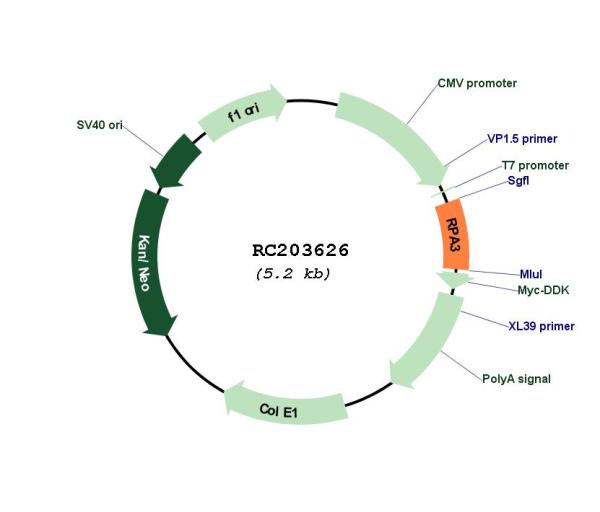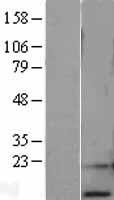RPA14 (RPA3) (NM_002947) Human Tagged ORF Clone
CAT#: RC203626
RPA3 (Myc-DDK-tagged)-Human replication protein A3, 14kDa (RPA3)
ORF Plasmid: tGFP
"NM_002947" in other vectors (6)
Need custom modification / cloning service?
Get a free quote
CNY 1,200.00
CNY 3,705.00
CNY 300.00
CNY 6,281.00
Specifications
| Product Data | |
| Type | Human Tagged ORF Clone |
| Tag | Myc-DDK |
| Synonyms | REPA3; RP-A p14 |
| Vector | pCMV6-Entry |
| E. coli Selection | Kanamycin (25 ug/mL) |
| Mammalian Cell Selection | Neomycin |
| Sequence Data |
>RC203626 ORF sequence
Red=Cloning site Blue=ORF Green=Tags(s) TTTTGTAATACGACTCACTATAGGGCGGCCGGGAATTCGTCGACTGGATCCGGTACCGAGGAGATCTGCC GCCGCGATCGCC ATGGTGGACATGATGGACTTGCCCAGGTCGCGCATCAACGCCGGCATGCTAGCTCAATTCATCGACAAGC CTGTCTGCTTCGTAGGGAGGCTGGAAAAGATTCATCCCACCGGAAAAATGTTTATTCTTTCAGATGGAGA AGGAAAAAATGGAACCATCGAGTTGATGGAACCCCTTGATGAAGAAATCTCTGGAATTGTGGAAGTGGTT GGAAGAGTAACCGCCAAGGCCACCATCTTGTGTACATCTTATGTCCAGTTTAAAGAAGATAGCCATCCTT TTGATCTTGGACTTTACAATGAAGCTGTGAAAATTATCCATGACTTCCCTCAGTTTTATCCTTTAGGGAT TGTGCAACATGAT ACGCGTACGCGGCCGCTCGAGCAGAAACTCATCTCAGAAGAGGATCTGGCAGCAAATGATATCCTGGATT ACAAGGATGACGACGATAAGGTTTAA >RC203626 protein sequence
Red=Cloning site Green=Tags(s) MVDMMDLPRSRINAGMLAQFIDKPVCFVGRLEKIHPTGKMFILSDGEGKNGTIELMEPLDEEISGIVEVV GRVTAKATILCTSYVQFKEDSHPFDLGLYNEAVKIIHDFPQFYPLGIVQHD TRTRPLEQKLISEEDLAANDILDYKDDDDKV |
| Chromatograms |
CHROMATOGRAMS
 Sequencher program is needed, download here. |
| Restriction Sites |
SgfI-MluI
Cloning Scheme for this gene
Plasmid Map

|
| ACCN | NM_002947 |
| ORF Size | 363 bp |
| OTI Disclaimer | The molecular sequence of this clone aligns with the gene accession number as a point of reference only. However, individual transcript sequences of the same gene can differ through naturally occurring variations (e.g. polymorphisms), each with its own valid existence. This clone is substantially in agreement with the reference, but a complete review of all prevailing variants is recommended prior to use. More info |
| OTI Annotation | This clone was engineered to express the complete ORF with an expression tag. Expression varies depending on the nature of the gene. |
| Product Components | The ORF clone is ion-exchange column purified and shipped in a 2D barcoded Matrix tube containing 10ug of transfection-ready, dried plasmid DNA (reconstitute with 100 ul of water). |
| Reconstitution | 1. Centrifuge at 5,000xg for 5min. 2. Carefully open the tube and add 100ul of sterile water to dissolve the DNA. 3. Close the tube and incubate for 10 minutes at room temperature. 4. Briefly vortex the tube and then do a quick spin (less than 5000xg) to concentrate the liquid at the bottom. 5. Store the suspended plasmid at -20°C. The DNA is stable for at least one year from date of shipping when stored at -20°C. |
| Note | Plasmids are not sterile. For experiments where strict sterility is required, filtration with 0.22um filter is required. |
| Reference Data | |
| RefSeq | NM_002947.5 |
| RefSeq Size | 1613 bp |
| RefSeq ORF | 366 bp |
| Locus ID | 6119 |
| UniProt ID | P35244 |
| Protein Families | Druggable Genome, Stem cell - Pluripotency |
| Protein Pathways | DNA replication, Homologous recombination, Mismatch repair, Nucleotide excision repair |
| MW | 13.6 kDa |
| Gene Summary | As part of the heterotrimeric replication protein A complex (RPA/RP-A), binds and stabilizes single-stranded DNA intermediates that form during DNA replication or upon DNA stress. It prevents their reannealing and in parallel, recruits and activates different proteins and complexes involved in DNA metabolism. Thereby, it plays an essential role both in DNA replication and the cellular response to DNA damage (PubMed:9430682). In the cellular response to DNA damage, the RPA complex controls DNA repair and DNA damage checkpoint activation. Through recruitment of ATRIP activates the ATR kinase a master regulator of the DNA damage response (PubMed:24332808). It is required for the recruitment of the DNA double-strand break repair factors RAD51 and RAD52 to chromatin, in response to DNA damage. Also recruits to sites of DNA damage proteins like XPA and XPG that are involved in nucleotide excision repair and is required for this mechanism of DNA repair (PubMed:7697716). Plays also a role in base excision repair (BER), probably through interaction with UNG (PubMed:9765279). Also recruits SMARCAL1/HARP, which is involved in replication fork restart, to sites of DNA damage. May also play a role in telomere maintenance. RPA3 has its own single-stranded DNA-binding activity and may be responsible for polarity of the binding of the complex to DNA (PubMed:19010961). As part of the alternative replication protein A complex, aRPA, binds single-stranded DNA and probably plays a role in DNA repair. Compared to the RPA2-containing, canonical RPA complex, may not support chromosomal DNA replication and cell cycle progression through S-phase. The aRPA may not promote efficient priming by DNA polymerase alpha but could support DNA synthesis by polymerase delta in presence of PCNA and replication factor C (RFC), the dual incision/excision reaction of nucleotide excision repair and RAD51-dependent strand exchange (PubMed:19996105).[UniProtKB/Swiss-Prot Function] |
Documents
| Product Manuals |
| FAQs |
| SDS |
Resources
Other Versions
| SKU | Description | Size | Price |
|---|---|---|---|
| RC203626L1 | Lenti ORF clone of Human replication protein A3, 14kDa (RPA3), Myc-DDK-tagged |
CNY 3,600.00 |
|
| RC203626L2 | Lenti ORF clone of Human replication protein A3, 14kDa (RPA3), mGFP tagged |
CNY 5,890.00 |
|
| RC203626L3 | Lenti ORF clone of Human replication protein A3, 14kDa (RPA3), Myc-DDK-tagged |
CNY 5,890.00 |
|
| RC203626L4 | Lenti ORF clone of Human replication protein A3, 14kDa (RPA3), mGFP tagged |
CNY 5,890.00 |
|
| RG203626 | RPA3 (tGFP-tagged) - Human replication protein A3, 14kDa (RPA3) |
CNY 2,800.00 |
|
| SC118291 | RPA3 (untagged)-Human replication protein A3, 14kDa (RPA3) |
CNY 1,200.00 |


 United States
United States
 Germany
Germany
 Japan
Japan
 United Kingdom
United Kingdom
 China
China



